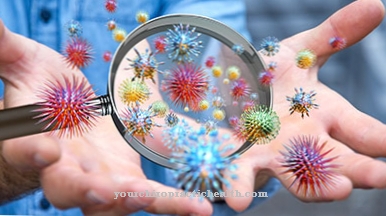Polyglobules means an increase in red blood cells. It is associated with increased blood thickening and increased hematocrit and thus causes circulatory disorders and various accompanying symptoms.
What is polyglobule?

© s29 - stock.adobe.com
A polyglobule is an increase in red blood cells. It is usually the result of another disease and can be divided into two forms.
On the one hand there is the primary and on the other hand the secondary form. The distinction can only be made by a medical professional as the symptoms are similar. Polyglobulia is similar to polycythemia, but is far more common. Polyglobules can be treated well nowadays and prevention is also unproblematic.
causes
A polyglobule usually results from a lack of oxygen, as a result of which the erythrocyte content is increased. The effect can therefore occur relatively quickly, especially when staying at great heights. The cause is an increased production of the hormone erythropoietin in the kidneys.
The hormone is the red blood cell growth factor. It can be said that any condition that results in prolonged oxygen deficiency leads to polyglobulia. The organism triggers the effect itself in order to ensure the supply of sufficient oxygen.
The symptoms are made easier by blocked vessels. The cause can therefore often be found in an unhealthy lifestyle. People who exercise little and use caffeine and cigarettes favor polyglobulia. Diseases of the heart and blood vessels, which often result in blood thickening, are also favored.
Symptoms, ailments & signs
Polyglobules lead to dizziness, ringing in the ears and recurring headaches. The affected person's skin is itchy all over their body, and the itching becomes worse when they come into contact with water. Occasionally there is also sharp pain or sensory disturbance. Some patients also develop nerve pain, which in turn can result in restricted mobility.
Outwardly, a polyglobulia can be seen in the strong reddening of the face and the blue coloration of the mucous membranes due to the circulatory disorders. The blood thickening also causes shortness of breath, heart cramps and pain in the limbs. High blood pressure increases the risk of thrombosis, stroke, and other serious complications.
If the polyglobules are not treated, the impaired blood circulation can lead to unconsciousness, a stroke or a heart attack. Furthermore, hearing problems can occur. Chronic high blood pressure also affects eyesight, the immune system and hormonal balance.
In the long term, an untreated polyglobule leads to organ damage. As a result of the permanent undersupply of the brain, certain brain areas die, which can result in irreversible neurological damage. In the worst case, an increase in red blood cells can lead to death. With extensive treatment, symptoms will go away once the blood is back to normal thickness.
Diagnosis & course
Polyglobulia manifests itself through several symptoms that are critical to the diagnosis. In a conversation with the person affected, the doctor can determine whether headaches occur as a result of the blood thickening, there is temporary shortness of breath or heart cramps occur.
If there is already a suspicion, an accurate diagnosis can be made relatively quickly from the anamnesis. However, a prerequisite is a measurement of blood pressure. In this way it can be determined whether there is actually a polyglobule.
The doctor can also use other examination methods. He checks lung function, performs a kidney ultrasound scan or does an ultrasound scan of the heart. X-rays of the lungs can also provide information about possible polyglobules. If the attending physician does not come to a result from the above-mentioned examinations, polycythemia must be assumed. In this case, a bone marrow puncture is done.
The course of the polyglobules can look very different. Mountaineers, for example, often suffer from the symptoms, but usually have normal blood values within a few days after the descent. Here the course of the disease is harmless and no long-term effects are to be expected. However, if the blood thickening occurs as a result of a chronic disease, there are far-reaching side effects.
Affected people can have problems with their blood vessels, suffer from thrombosis and generally feel very unwell. In addition, the heart is stressed much more, which increases the risk of heart disease. Finally, polyglobules can also limit mental abilities.
Complications
Because of the polyglobulia, those affected usually suffer from a significant thickening of the blood. This leads to serious circulatory disorders, so that in the worst case, those affected can lose consciousness and die of these complaints. Likewise, the risk of a stroke or a heart attack increases significantly through polyglobules.
Thromboses can also occur and make everyday life more difficult for those affected. Due to the insufficient supply of oxygen, the skin also turns blue. If the undersupply persists, the internal organs and the brain will be significantly damaged. This damage is usually irreversible. This disease can also cause hearing problems or headaches. Treatment of polyglobules depends on the underlying disease.
As a rule, it cannot be universally predicted whether this will lead to complications. Those affected may also be dependent on an operation. In severe cases, a heart transplant may also be necessary to fully treat the symptoms of polyglobules. The life expectancy of the patient may also be limited by polyglobules.
When should you go to the doctor?
Polyglobules should always be examined by a doctor. In the worst case, this disease can lead to death. As a rule, self-healing does not occur. The doctor should be consulted in the case of polyglobules if severe itching occurs, which occurs for no particular reason and which persists over a longer period of time.
The itching can appear all over the body and significantly reduce the patient's quality of life. Furthermore, there are also disorders of sensitivity and severe headaches all over the body. Restrictions in movement or severe pain in the limbs often point to polyglobulia and must be examined by a doctor. The disease can also lead to a heart attack or a stroke, in which case an emergency doctor should be called immediately or the hospital should be visited.
The polyglobulia can primarily be diagnosed by a general practitioner. However, further treatment is carried out by a specialist and depends on the exact severity of the symptoms. In many cases the patient's life expectancy is limited by the polyglobules.
Treatment & Therapy
Depending on whether it is a primary or secondary polyglobule, other measures must be taken. The secondary form can either be obstructive pulmonary disease or heart failure.
The latter disease is treated with the help of various drugs such as ACE inhibitors, beta blockers and diuretics. A pacemaker can also be used. A heart transplant is also an option if the medication treatment does not work. The polyglobulin usually disappears as the blood thickness decreases.
If the underlying disease cannot be treated, bloodletting therapy can be initiated. Blood is drawn from the patient at regular intervals and fluids are introduced intravenously. This is to reduce blood thickening. The flow properties of the blood can also improve significantly through the treatment.
prevention
Polyglobules can be prevented well. A healthy lifestyle with plenty of exercise and a balanced diet can greatly reduce the risk. In general, it is important to drink a lot to prevent blood thickening.
Anyone who also refrains from alcohol, cigarettes and caffeine can avoid polyglobules. Poisons and pollutants that accumulate in the veins and vessels favor the disease, which is why regular purification is advisable. Lastly, a regular preventive check-up with regard to polyglobules can only be positive.
Polycythemia cannot be prevented. However, the chances of recovery increase if the disease is detected early. Therefore you should also have the bone marrow examined at regular intervals. People who have to accept greater differences in altitude at work can counteract this by taking medication that thins the blood.
Aftercare
In most cases, the affected person has very few follow-up measures available, and in some cases these can even be completely limited. Therefore, the patient should consult a doctor at the first symptoms and signs of the disease in order to prevent further worsening of the symptoms. In most cases, the polyglobules cannot heal themselves, so ideally an early diagnosis and subsequent treatment should take place.
Most of those affected are dependent on the intake of various medications for polyglobules. The patient should always pay attention to regular intake and also to the correct dosage of the medication in order to relieve the symptoms permanently and above all correctly. Regular check-ups by a doctor are also very important in order to identify and treat further damage to the internal organs.
In general, with polyglobules, a healthy lifestyle with a healthy diet also has a positive effect on the further course of the disease. The doctor can also create a nutrition plan for the patient. This disease may reduce the life expectancy of the person affected.
You can do that yourself
If polyglobules develop as a result of a chronic disease, both the polyglobules themselves and the underlying disease must be treated urgently. The polyglobules alone can otherwise lead to long-term organ damage and, if left untreated, even be fatal. Close medical treatment is therefore urgently recommended. The aim is to cure the disease on which the polyglobule is based and thus also the polyglobule itself.
The patient can effectively support this with lifestyle measures. Those affected should exercise regularly and exercise a lot overall. Patients with polyglobules should not smoke or drink alcohol. Coffee is also said to have an adverse effect on the disease and should therefore be avoided. Purification and detoxification measures are recommended for a polyglobulia patient, because it is the toxins and pollutants that accumulate in the vessels and bloodstream and thus promote the disease. Regular saunas or steam baths gently detoxify the organism. Doctors or non-medical practitioners who are experienced in naturopathic medicine provide further recommendations for diversion and detoxification.
It is important to give the body rest during the detox process. This also includes getting enough sleep at set times. A healthy diet rich in vitamins and fiber also helps detox. Patients should avoid dark meat and prefer fruit and vegetables.





.jpg)











.jpg)







.jpg)


